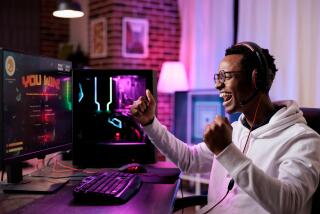For Sale: 1 Couch
- Share via
I confess I don’t know much about video games, and I’m about as qualified to compare the newest PlayStation 3 and Nintendo Wii consoles as I am to assemble a helicopter in my garage. But there was something deeply compelling about the sight of all those hundreds of gamers and EBay entrepreneurs camped out around electronics stores the weekend before Thanksgiving. It felt like some mysterious seasonal migration, like sea turtles, swallows and salmon. La Marche des Canapes de Pommes de Terre.
Soon after the waves of humanity subsided, I wandered into my local Best Buy to check out a favorite PlayStation romp, “Guitar Hero II,” the follow-up to the sleeper hit from RedOctane Inc. Using tiny Playskool-like guitars, players try to hit “notes” streaming at them onscreen by pressing the corresponding buttons on the controller’s fret board. The notes are sort of musical tablature for whichever of the 64 rocking songs you pick out--”Free Bird,” anyone?--but the game is only musical in the sense that players have to tap the strum-bar in time. Rhythm does help.
It’s simple, but it’s definitely not easy. Maddening, in fact. I’m modestly capable on a guitar and I couldn’t even fake my way through “War Pigs,” Black Sabbath’s lugubrious dirge of distortion (other songs include Wolfmother’s “Woman” and Primus’ “John the Fisherman”). I soon surrendered the teeny Gibson SG to Saro Manoukian, a 25-year-old with a dark ponytail and a Playboy Jazz Festival T-shirt. He squared off against another shopper in a Slayer T-shirt while I joined the mosh pit around the console.
Saro proceeded to totally rock it. “It’s actually easier for a piano player to pick it up,” said Saro, who admitted that when he was learning the game he spent up to five hours a day practicing. There was even a rumored version to be called “Accordion Hero.” Can’t wait for “Klezmer Hero.”
And so the inevitable question: If it takes so long to learn how to play, wouldn’t it be more elegant to learn to play a real guitar? “It’s more fun,” said Saro. “It’s more interactive, and you get feedback,” noting the virtual crowds screaming at the feet of his onscreen avatar. “It’s like playing a real gig.”
Saro is a part-time game tester and full-time med student, which doesn’t exactly compute with the video-slacker meme. In a leisure-obsessed culture such as ours, it’s unfair to chide gamers for wasting time (at least while golf is still legal). But if I had put as much time into academics as these games, I could have landed the Lucasian chair at Cambridge.
As I said, I don’t follow gaming very closely. The last title I worked my way through was “Medal of Honor: Frontline” several years ago and, yes, I saved the world from the Nazi scourge. Sometime in the 1980s I played bookcase games from Avalon Hill, which were the cardboard analog to the sprawling online strategy games like “World of Warcraft” and “Rome: Total War.”
While I wasn’t looking, a class of interactive gaming emerged that has, in essence, banished the couch. It began, Saro informed me, with Dance Dance Revolution, where players move on a flood pad equipped with sensors. This year West Virginia’s Department of Education began putting DDR in all of its public schools in an effort to combat childhood obesity. Cardio-minded gamers might also want to check out “EyeToy: Kinetic,” another PlayStation title that uses a USB-connected camera to superimpose an image of the player on the screen, scoring points by how well he or she keeps up with the digital aerobics instructor (a chilling phrase, isn’t it?). In a similar vein is “Real World Golf.” Players strap on motion sensors and use a stubby little club to hack away. The system is so sensitive that it can tell if you actually hit a fade or a draw, which is great because sometimes I can’t even tell.
The triumph of the physically interactive video game, the actual for the virtual, is presaged by the new Nintendo Wii. Forgoing the usual bristling-with-buttons controllers, Wii (pronounced “wheeee”) uses a pair of motion-sensitive controllers--a palm-shaped object and a stick-like “nunchuk”--to interact with the virtual environment. To box, you take hold of the controllers and go a few rounds with thin air. Wii favors sports simulations: tennis, baseball, bowling. Our generation had something similar: We called it exercise.
There seems to be something important underfoot. This morphing of video games from passive, gape-mouthed pastimes to something more physical, something more thoroughly immersive, has staggering possibilities. Just as the priests of convergence predicted, video environments have become so surreally persuasive and eidetic that we can’t resist diving into these synthetic worlds, where we can break a sweat, learn to dance, practice our surgery, be a rock god. Welcome to the Holodeck.
I’m beginning to wonder what I saw in the real world in the first place.
More to Read
The biggest entertainment stories
Get our big stories about Hollywood, film, television, music, arts, culture and more right in your inbox as soon as they publish.
You may occasionally receive promotional content from the Los Angeles Times.










